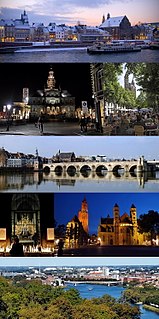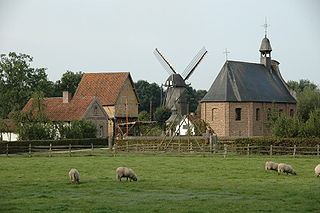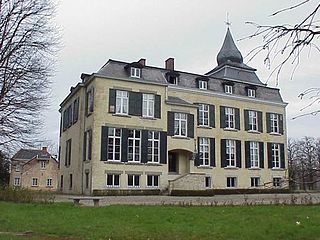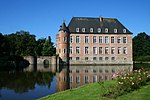
Maastricht is a city and a municipality in the southeastern Netherlands. It is the capital and largest city of the province of Limburg. Maastricht is located on both sides of the Meuse, at the point where the Jeker joins it. Mount Saint Peter (Sint-Pietersberg) is largely situated within the city's municipal borders. Maastricht is adjacent to the border with Belgium. It is part of the Meuse-Rhine Euroregion, a metropolis with a population of about 3.9 million, which includes the nearby German and Belgian cities of Aachen, Liège and Hasselt.

Limburg is a province in Belgium. It is the easternmost of the five Dutch-speaking provinces that together form the Region of Flanders, one of the three main political and cultural sub-divisions of modern Belgium.

Heerlen is a city and a municipality in the southeast of the Netherlands. It is the third largest settlement proper in the province of Limburg. Measured as municipality, it is the fourth municipality in the province of Limburg.

Valkenburg aan de Geul is a municipality situated in the southeastern Dutch province of Limburg. The name refers to the central town in the municipality, Valkenburg, and the small river Geul.

Grimbergen is a municipality in the Belgian province of Flemish Brabant, 10 km north of the capital Brussels. It comprises the towns of Beigem, Grimbergen, Humbeek and Strombeek-Bever. In 2017, it had a population of 37,030 and an area of 38.61 km2, giving a population density of 959 inhabitants per km2.

Nieuwerkerken is a municipality located in the Belgian province of Limburg near Hasselt. On January 1, 2006, Nieuwerkerken had a total population of 6,606. The total area is 22.46 km² which gives a population density of 294 inhabitants per km². It consists of 4 villages: Binderveld, Wijer, Kozen and Nieuwerkerken. The current mayor is Dries Deferm.

Maaseik is a city and municipality in the Belgian province of Limburg. Both in size and in population, it is the 8th largest municipality in Limburg. The town is the seat of the administrative arrondissement of Maaseik (kieskanton). Internationally, Maaseik is known as the assumed birthplace of the famous Flemish painters Jan and Hubert van Eyck.

Borgloon is a city and municipality located in the Belgian province of Limburg. On January 1, 2006, Borgloon had a total population of 10,697. The total area is 51.12 km2 which gives a population density of 209 inhabitants per km2. Borgloon gave its name to the former county of Loon and was its capital until 1200.

The house of Limburg Stirum, which adopted its name in the 12th century from the immediate county of Limburg an der Lenne in what is now Germany, is one of the oldest families in Europe. It is the eldest and only surviving branch of the House of Berg, which was among the most powerful dynasties in the region of the lower Rhine during the Middle Ages. Some historians link them to an even older dynasty, the Ezzonen, going back to the 9th century.

The Bokrijk Provincial Domain is a park and museum complex near Genk, Province of Limburg in Belgium. It is known for its open-air museum which displays a large collection of historical buildings from across Flanders which presents the history of rural life in the region. The domain is 5.5 square kilometres (2.1 sq mi) in area and also hosts an important botanical garden (arboretum), nature reserve, and the largest open-air playground in Flanders.

Aspremont-Lynden Castle is a castle in Oud-Rekem in the municipality of Lanaken, province of Limburg, Belgium.

Diepenbeek Castle is a castle in Diepenbeek near Hasselt in the province of Limburg, Belgium. The building consists of a 15th-century keep with a 17th-century main block. It was once the establishment of the steward of the nearby Commandery of Alden Biesen, whence the alternative name.

Hamal Castle is a castle in Rutten near Tongeren in the province of Limburg, Belgium, once the centre of the small independent lordship of Rutten. The castle was first mentioned in 1214. The current castle dates from the late 18th century.

Hasselbroek Castle, also Hasselbrouck Castle is a 17th-century country house in Hasselbroek, in Jeuk, a part of the municipality of Gingelom, province of Limburg, Belgium.

Heers Castle is a castle in Heers, Province of Limburg, Belgium.

Ommerstein Castle is a castle in the village of Rotem in the municipality of Dilsen-Stokkem, province of Limburg, Belgium.
South Limburg is both a COROP (statistical) region as well as a landstreek (area) of the Netherlands located in the province of Limburg. The Dutch term landstreek, literally translated "land area/region", means that the area is not an administrative region but an area that displays cohesion with regard to culture and landscape. With regards to South Limburg this deals with its hilly landscape, especially in the Heuvelland region, sunken lanes, an abundance of castles, and the regional language Limburgish spoken by a significant part of the population alongside Dutch. The region also contains the highest point above sea level in mainland Netherlands, the Vaalserberg being 322.5 metres (1,058 ft) above sea level.
Mosan Renaissance, also known as Maasland Renaissance, is a regional architectural style dating from the 16th and 17th centuries. The style is only remotely related to Renaissance architecture. The term should not be confused with Mosan art, which applies to Romanesque art and architecture during the Middle Ages in the region of the Meuse river valley.

Rutten is a village in the Tongeren municipality of the Limburg province in the Flemish Community of Belgium. The village is located in the Haspengouw region, and was a separate municipality until its merger into Tongeren in 1977.

Peten Castle is a 19th-century castle in Velm (Sint-Truiden), Belgium.






















